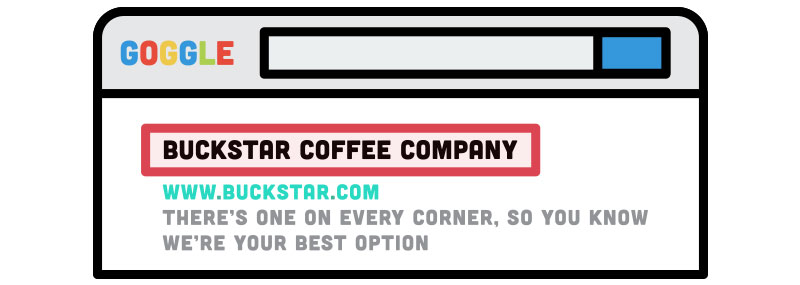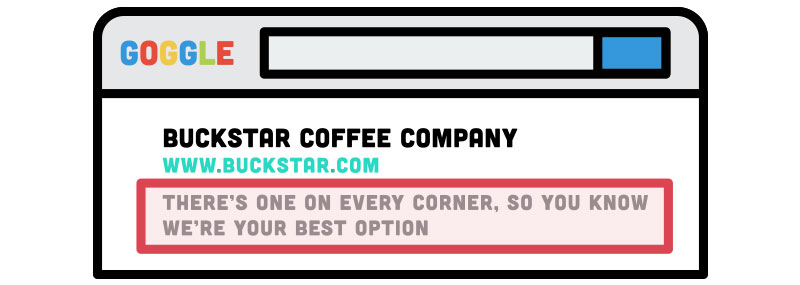Review How Your Meta Data Looks in Google
What is a meta title tag?
The title tag is an element of HTML that specifies a web page’s title. Title tags get displayed in the SERPS (search engine results pages) in the form of a clickable headline for a specific result. They are important for SEO, usability, and social sharing. A web page’s title tag is intended to be a concise and accurate description of the content on a page and should help searchers anticipate what they will find when they click on your listing.
Why are title tags important?
What makes title tags so important is they play a role in helping users (and search engines) understand what your web page is all about. They are also often the first impression a visitors has of a web page.
There are three key places where title tags are used: (1) web browsers, (2) search engine results, and (3) social networks.
1. Web browsers
A title tag is displayed in the top part of the web browser and performs the role of a placeholder, particularly for individuals who have numerous browser tabs open at the same time. Easily recognizable and unique titles that have important keywords close to the front to help to ensure that user come back to your page.
2. Search engine result pages
The title tag determines the display title in the SERPs (Search Engine Results Pages) and is a visitor’s initial experience of your website. Even when your website ranks high in search, a good tile can still be the make-or-break factor when it comes to determining whether or not a person will click on your link and visit your website.
3. Social networks
There are some external websites (social networks in particular) that use your title tags in order to determine what should be displayed when your page is shared.
Remember that some social networks (including Twitter and Facebook) have meta tags of their own, which allows you to specify titles that are different from the main title tags you use. That makes it possible for you to optimize for each of the networks, and offer longer titles where and when that may be beneficial.
2019 Best Practices For Good Title Tags
- Since Google generally displays the between 50-60 characters of your title tag, it’s best to keep your title length to 60 characters or less. If you do this, you increase the odds that your entire title tag will be shown in the search results.
- Describe the content of your pages accurately at all times. Choose a title that effectively communicates the topic of the content on the page and reads naturally.
- Create a unique title for each of your pages. That will help Google know how your page is distinct from the other pages on your website.
- Use descriptive, but brief titles. Titles should be informative but still short. If it is less relevant or too long, Google might only display part of it or one that is generated automatically within Google’s search result.
- The most critical step is making sure you conduct thorough keyword research so that your title tag contains high-value keywords.
What is a meta description tag?
A meta description is an attribute of HTML that offers a brief summary of a specific web page. Google and other search engines frequently will display the meta description – usually up to 160 characters in length – in their search results. They can greatly influence the click-through rates of users.
Why meta descriptions are important
Although meta description tags are not tied directly to search engine rankings, they are very important in obtaining click-through from the search engine results pages. The short paragraphs give an opportunity for the webmaster to advertise their content to searchers and gives the searcher the opportunity to decide whether or not the content is relevant to what they are looking and contains the information they are searching for with their search query.
The meta description of a page should read in a non-spammy, active, and natural way. It should use keywords that are being targeted by the page and also create a description that is compelling and will entice a searcher to click it. The meta description should directly relate to the page it is describing and be unique from other page descriptions.
2019 Best Practices For A Good Meta Description Length
- Summarize the page content accurately. Although there is no maximum or minimum meta title length for the description text, Google recommends that you make it long enough so that it is completely shown in Google’s search results (note that users might see different sizes of snippets depending on where and how they do their searches).
- Use a unique description on each page. When you have a different meta tag description on each of your pages it helps both Google and users, especially in searches where a user might bring up several pages from your domain.
- Ensure that your meta descriptions are kept to the ideal length of a maximum of 160 characters, which includes spaces.
- Naturally include your main keyword or a variant of it in your description.
Ready To Take things to the next Level?
If you think an SEO campaign with Enleaf is what your business needs, then contact us for a free SEO audit! We’ll have a look at your site, make contact and discuss where your site is at and where it could go. Enleaf’s SEO professionals won’t promise you the moon, as no provider ever should, but instead will give you a realistic assessment of what can be done with your website. We hire dedicated professionals that can and do deliver real results on a regular basis, so you will know what you can expect.
Contact us for a Free Quote


